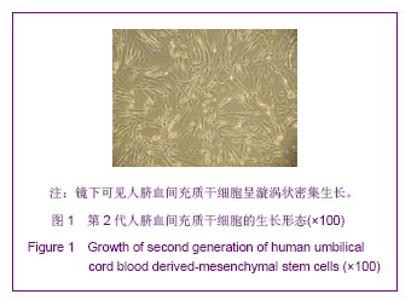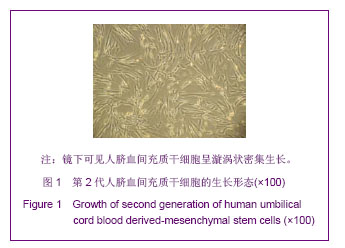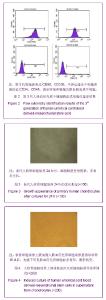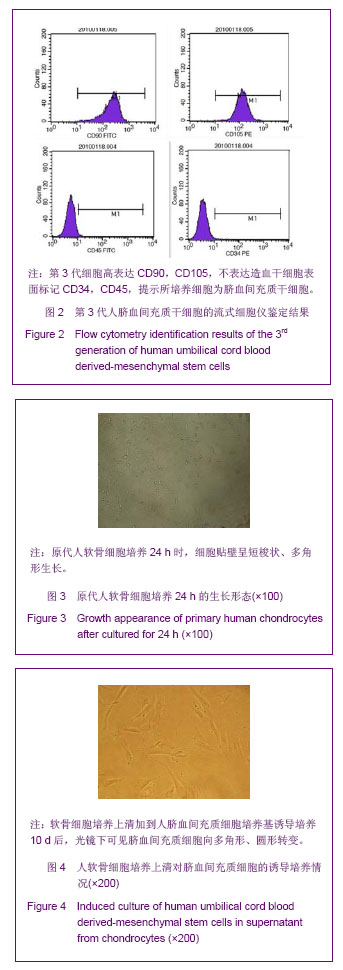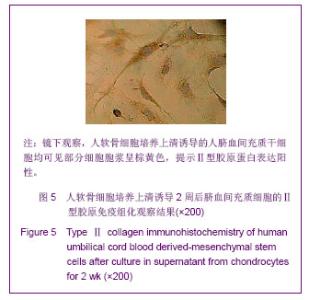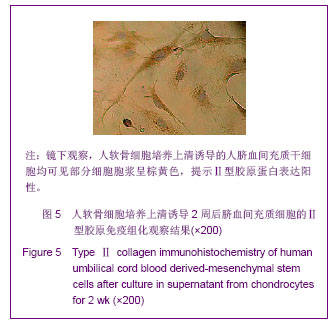Chinese Journal of Tissue Engineering Research ›› 2013, Vol. 17 ›› Issue (40): 7034-7039.doi: 10.3969/j.issn.2095-4344.2013.40.003
Previous Articles Next Articles
Differentiation of human umbilical cord blood derived-mesenchymal stem cells into chondrocytes induced by supernatants of human chondrocytes
Zhou Feng, Wang Ying-zhen, Zhang Hai-ning, Lü Cheng-yu, Xu Zong-yao
- Qingdao University Medical School, Qingdao 266003, Shandong Province, China
-
Online:2013-10-01Published:2013-10-31 -
Contact:Zhang Hai-ning, Associate chief physician, Qingdao University Medical School, Qingdao 266003, Shandong Province, China -
About author:Zhou Feng★, Master, Qingdao University Medical School, Qingdao 266003, Shandong Province, China yuyenongcha@163.com -
Supported by:the National Natural Science Foundation of China, No. 81171774*, 81272056*
CLC Number:
Cite this article
Zhou Feng, Wang Ying-zhen, Zhang Hai-ning, Lü Cheng-yu, Xu Zong-yao. Differentiation of human umbilical cord blood derived-mesenchymal stem cells into chondrocytes induced by supernatants of human chondrocytes[J]. Chinese Journal of Tissue Engineering Research, 2013, 17(40): 7034-7039.
share this article
| [1]Ishikawa F, Shimazu H, Shultz LD, et al. Purified human hematopoietic stem cells contribute to the generation of cardiomyocytes through cell fusion. FASEB J. 2006;20(7): 950-952. [2]Lee OK, Kuo TK, Chen WM, et al. Isolation of multipotent mesenchymal stem cells from umbilical cord blood. Blood. 2004;103(5):1669-1675. [3]Rao J, Shen J, Quan D, et al. Property studies on three-dimensional porous blended silk scaffolds. Zhongguo Xiu Fu Chong Jian Wai Ke Za Zhi.2009;23(10):1264-1270. [4]Huang Y, Dai ZQ, Ling SK, et al. Gravity, a regulation factor in the differentiation of rat bone marrow mesenchymal stem cells. J Biomed Sci. 2009;16:87. [5]Schulze-Tanzil G, Mobasheri A, de Souza P, et al. Loss of chondrogenic potential in dedifferentiated chondrocytes correlates with deficient Shc-Erk interaction and apoptosis. Osteoarthritis Cartilage.2004;12(6):448-458. [6]Secco M, Zucconi E, Viera NM, et al. Multipotent stem cells from umbilical cord: cord is richer than blood! Stem Cells. 2008;26:146-150. [7]Secco M, Zucconi E, Viera NM, et al. Multipotent stem cells from umbilical cord: cord is richer than blood! Stem Cells. 2008;26:146-150. [8]蓝孝同,王英振.骨髓间充质干细胞治疗骨性关节炎的研究进展[J].齐鲁医学杂志,2010,25(2):186-188. [9]Szpalski C,Barbaro M,Saqebin F,et al. Bone tissue engineering:current strategies and techniques--part II:Cell types. Tissue Eng Part B Rev.2012;18(4):258-269. [10]于艳秋,任海琴,云伟,等.人类脐血来源的间充质干细胞向软骨和成骨细胞分化的实验研究[J].生物医学工程学杂志,2008, 25(6):1385-1389. [11]解继胜,黄海玲,唐毓金,等.人脐带血间充质干细胞分离培养及向软骨细胞分化[J].中国组织工程研究与临床康复,2008,12(16): 3065-3068. [12]Au A, Boehm CA, Mayes AM, et al. Formation of osteogenic colonies on well-defined adhesion peptides by freshly isolated human marrow cells. Biomaterials,2007,28(10):1847-1861. [13]Broxmeyer HE. Insights into the biology of cord stem/progenitor cells. Cells Prolif. 2011;44:55-59. [14]Fonseka M, Ramasamy R, Yip WK, et al. Human Umbilical Cord Blood-Derived Mesenchymal Stem Cells (hUCB-MSC) Inhibits the Proliferation of K562 (Human Erythromyeloblastoid Leukemic Cell Line).Cell Biol Int. 2012. [Epub ahead of print] [15]Kim JS, Lee HK, Kim MR, et al. Differentially expressed proteins of mesenchymal stem cells derived from human cord blood (hUCB) during osteogenic differentiation. Biosci Biotechnol Biochem. 2008;72(9):2309-2317. [16]Gennery AR,Cant AJ. Cord blood stem cell transplantation in primary immune deficiencies. Curr Opin Allergy Clin Immunol. 2007;7(6):528-534. [17]Erices A, Conget P, Mingudl JJ, et al. Meaenchymaal progenitor cells in human umbilical cord blood. Br J Heamatol. 2000;109:235-242. [18]Malgieri A,Kantzari E,Patrizi MP,et al. Bone marrow and umbilical cord blood human mesenchymal stem cells:state of the art. Int J Clin Exp Med. 2010;3:248-269. [19]Mohyeddin Bonab MA, Alimoghaddam KA,Goliaei ZA, et al. Which factors cm affect cord blood variables?Transfusion. 2004:44(5);690-693. [20]Sibov TT, Severino P, Marti LC, et al. Mesenchymal stem cells from umbilical cord blood: parameters for isolation, characterization and adipogenic differentiation. Cytotechnology. 2012;64(5):511-521. [21]Ma LL, Meng FB, Shi P, et al. Quantity and proliferation rate of mesenchymal stem cells in human cord blood during gestation. Cell Biol Int. 2012;36(4):415-418. [22]Liu QH, Ge J, Liu KY. Are CD133 and CD271 useful in positive selection to enrich umbilical cord blood mesenchymal stem cells? Zhongguo Shi Yan Xue Ye Xue Za Zhi. 2010; 18(5): 1286-1291. [23]Zhang H, Li A, Rao GZ, et al. Isolation of mesenchymal stem cells from human umbilical cord blood and its bone inducing activity in vitro. Shanghai Kou Qiang Yi Xue. 2010;19(3): 290-295. [24]Zhang Y, Wang L, Yang M, et al. Experimental study on culture of human mesenchymal stem cells from cord blood using autologous serum Sheng Wu Yi Xue Gong Cheng Xue Za Zhi. 2008;25(5):1155-1160. [25]Fan X, Liu T, Liu Y, et al. Optimization of primary culture condition for mesenchymal stem cells derived from umbilical cord blood with factorial design. Biotechnol Prog. 2009; 25(2):499-507. [26]Rong LJ, Chi Y, Yang SG, et al. Effects of interferon-γ on biological characteristics and immunomodulatory property of human umbilical cord-derived mesenchymal stem cells Zhongguo Shi Yan Xue Ye Xue Za Zhi. 2012;20(2):421-426. [27]Jang MW, Yun SP, Park JH, et al. Cooperation of Epac1/Rap1/Akt and PKA in prostaglandin E(2) -induced proliferation of human umbilical cord blood derived mesenchymal stem cells: involvement of c-Myc and VEGF expression.J Cell Physiol. 2012;227(12):3756-3767. [28]Ko E, Lee KY, Hwang DS. Human umbilical cord blood-derived mesenchymal stem cells undergo cellular senescence in response to oxidative stress. Stem Cells Dev. 2012;21(11):1877-1886. [29]Laitinen A, Nystedt J, Laitinen S. The isolation and culture of human cord blood-derived mesenchymal stem cells under low oxygen conditions. Methods Mol Biol. 2011;698:63-73. [30]Kern S, Eichler H, Stoeve J, et al. Comparative analysis of mesenchymal stem cells from bone marrow, umbilical cord blood, or adipose tissue, Stem Cells. 2006;24(5):1294-1301. [31]Gong W, Han Z, Zhao H, et al. Banking human umbilical cord-derived mesenchymal stromal cells for clinical use.Cell Transplant. 2012;21(1):207-216. [32]邹叶青,贺文凤,石庆之,等.骨髓与脐带血间充质干细胞的生物学特性比较[J].中国组织工程研究与临床研究,2008,12(21): 4141-4143. [33]高杨,李立,冉江华,等. 两种分离脐血间充质干细胞的方法比较[J].中国组织工程研究与临床康复, 2011,15(19):3472-3475. [34]Dominici M, Le Blanc K, Mueller I, et al. Minimal criteria for defining multipotent mesenchymal stromal cells. The International Society for Cellular Therapy position statement. Cytotherapy. 2006;8(4):315-317. [35]Hirvonen T, Suila H, Kotovuori A, et al. The i blood group antigen as a marker for umbilical cord blood-derived mesenchymal stem cells.Stem Cells Dev. 2012;21(3): 455-464. [36]Yu Y,Ren H,Yun W,et al. Differentiation of human umbilical cord blood-derived mesenchymal stem cells into chondroblast and osteoblasts. Sheng Wu Yi Xue Gong Cheng Xue Za Zhi. 2008;25(6):1385-1389. [37]农丕地,解继胜,黄海玲.体外诱导人脐带血间充质干细胞为软骨细胞的初步研究[J].右江民族医学院学报,2007,29(5):689-691. [38]Yan H,Yu C.Repair of full-thickness cartilage defects with cells of different origin in a rabbit model. Arthroscopy. 2007; 23(2): 178-187. [39]Fenq X,Tian S,Sun K,et al. Effect of platelet lysate on chondrogenic differentiation of human umbilical cord derived mesenchymal stem cells in vitro. Zhongguo Xiu Fu Chong Jian Wai Ke Za Zhi. 2011;25(10):1250-1255. [40]Jin HJ,Park SK,Oh W,et al. Down-regulation of CD105 is associated with multi-lineage differentiation in human umbilical cord blood-derived mesenchymal stem cells. Biochem Biophys Res Commun. 2009;381(4):676-681. [41]Blain EJ. Mechanical regulation of matrix metalloproteinases. Front Biosci. 2007;12:507-527. [42]李丽艳,杜江,黄金中.兔软骨细胞诱导人脐血间充质干细胞成软骨的可行性[J].中国组织工程研究与临床康复,2009,13(49): 9713-9714. |
| [1] | Wang Jing, Xiong Shan, Cao Jin, Feng Linwei, Wang Xin. Role and mechanism of interleukin-3 in bone metabolism [J]. Chinese Journal of Tissue Engineering Research, 2022, 26(8): 1260-1265. |
| [2] | Xiao Hao, Liu Jing, Zhou Jun. Research progress of pulsed electromagnetic field in the treatment of postmenopausal osteoporosis [J]. Chinese Journal of Tissue Engineering Research, 2022, 26(8): 1266-1271. |
| [3] | Tian Chuan, Zhu Xiangqing, Yang Zailing, Yan Donghai, Li Ye, Wang Yanying, Yang Yukun, He Jie, Lü Guanke, Cai Xuemin, Shu Liping, He Zhixu, Pan Xinghua. Bone marrow mesenchymal stem cells regulate ovarian aging in macaques [J]. Chinese Journal of Tissue Engineering Research, 2022, 26(7): 985-991. |
| [4] | Hou Jingying, Guo Tianzhu, Yu Menglei, Long Huibao, Wu Hao. Hypoxia preconditioning targets and downregulates miR-195 and promotes bone marrow mesenchymal stem cell survival and pro-angiogenic potential by activating MALAT1 [J]. Chinese Journal of Tissue Engineering Research, 2022, 26(7): 1005-1011. |
| [5] | Zhou Ying, Zhang Huan, Liao Song, Hu Fanqi, Yi Jing, Liu Yubin, Jin Jide. Immunomodulatory effects of deferoxamine and interferon gamma on human dental pulp stem cells [J]. Chinese Journal of Tissue Engineering Research, 2022, 26(7): 1012-1019. |
| [6] | Liang Xuezhen, Yang Xi, Li Jiacheng, Luo Di, Xu Bo, Li Gang. Bushen Huoxue capsule regulates osteogenic and adipogenic differentiation of rat bone marrow mesenchymal stem cells via Hedgehog signaling pathway [J]. Chinese Journal of Tissue Engineering Research, 2022, 26(7): 1020-1026. |
| [7] | Wang Jifang, Bao Zhen, Qiao Yahong. miR-206 regulates EVI1 gene expression and cell biological behavior in stem cells of small cell lung cancer [J]. Chinese Journal of Tissue Engineering Research, 2022, 26(7): 1027-1031. |
| [8] | Liu Feng, Peng Yuhuan, Luo Liangping, Wu Benqing. Plant-derived basic fibroblast growth factor maintains the growth and differentiation of human embryonic stem cells [J]. Chinese Journal of Tissue Engineering Research, 2022, 26(7): 1032-1037. |
| [9] | Wen Dandan, Li Qiang, Shen Caiqi, Ji Zhe, Jin Peisheng. Nocardia rubra cell wall skeleton for extemal use improves the viability of adipogenic mesenchymal stem cells and promotes diabetes wound repair [J]. Chinese Journal of Tissue Engineering Research, 2022, 26(7): 1038-1044. |
| [10] | Zhu Bingbing, Deng Jianghua, Chen Jingjing, Mu Xiaoling. Interleukin-8 receptor enhances the migration and adhesion of umbilical cord mesenchymal stem cells to injured endothelium [J]. Chinese Journal of Tissue Engineering Research, 2022, 26(7): 1045-1050. |
| [11] | Luo Xiaoling, Zhang Li, Yang Maohua, Xu Jie, Xu Xiaomei. Effect of naringenin on osteogenic differentiation of human periodontal ligament stem cells [J]. Chinese Journal of Tissue Engineering Research, 2022, 26(7): 1051-1056. |
| [12] | Wang Xinmin, Liu Fei, Xu Jie, Bai Yuxi, Lü Jian. Core decompression combined with dental pulp stem cells in the treatment of steroid-associated femoral head necrosis in rabbits [J]. Chinese Journal of Tissue Engineering Research, 2022, 26(7): 1074-1079. |
| [13] | Fang Xiaolei, Leng Jun, Zhang Chen, Liu Huimin, Guo Wen. Systematic evaluation of different therapeutic effects of mesenchymal stem cell transplantation in the treatment of ischemic stroke [J]. Chinese Journal of Tissue Engineering Research, 2022, 26(7): 1085-1092. |
| [14] | Guo Jia, Ding Qionghua, Liu Ze, Lü Siyi, Zhou Quancheng, Gao Yuhua, Bai Chunyu. Biological characteristics and immunoregulation of exosomes derived from mesenchymal stem cells [J]. Chinese Journal of Tissue Engineering Research, 2022, 26(7): 1093-1101. |
| [15] | Huang Chenwei, Fei Yankang, Zhu Mengmei, Li Penghao, Yu Bing. Important role of glutathione in stemness and regulation of stem cells [J]. Chinese Journal of Tissue Engineering Research, 2022, 26(7): 1119-1124. |
| Viewed | ||||||
|
Full text |
|
|||||
|
Abstract |
|
|||||
